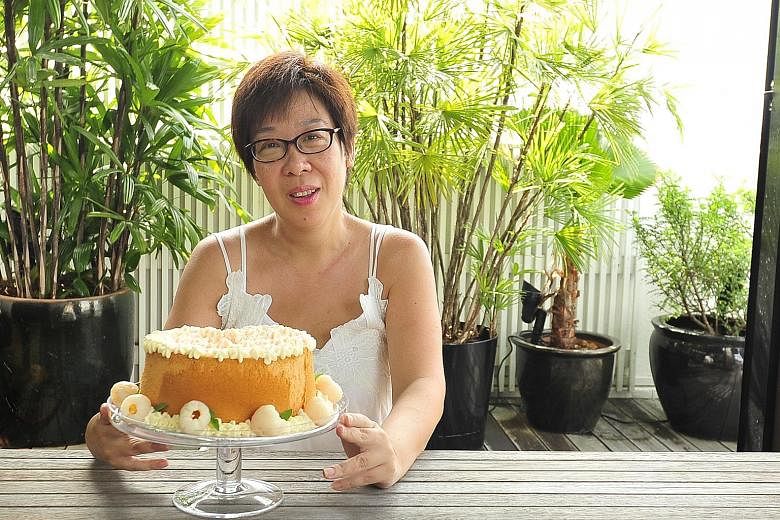Growing up, cooking was the last thing on housewife Angeline Lim's mind. The bubbly 51-year-old remembers that she grudgingly helped to make pineapple tarts, kueh lapis, kueh bahulu and fruit and butter cakes during Chinese New Year and Christmas.
Her Peranakan family sold these goodies to relatives and neighbours, and the kitchen was turned into a "production line".
She says with a laugh: "Back then, I though it was obiang (uncool) to be cooking. Perhaps it was because I attended a convent school for 10 years and we learnt that women should be independent and not always be in the kitchen."
She also stayed away from the kitchen as her grandmother was very particular about cooking, down to which direction the knife should point when chopping vegetables.
It was only two years ago that she picked up baking, after retiring from her trading assistant job in the foreign exchange industry, one she held for 25 years.
Disappointed with cloyingly sweet and overpriced cakes in bakeries, she started baking classic butter and marble cakes from recipes that her elder sister, 64, got from their late mother.
-

-
MAKE IT YOURSELF: Rose chiffon cake
-
INGREDIENTS
20ml rose syrup
1 1/2 tsp rose essence
80ml fresh milk
5 eggs, whites and yolks separated
95g caster sugar
70ml soya bean oil
100g cake flour
10g corn flour
10 lychees from a can
Lime basil leaves
For frosting
300ml whipping cream
11/2 to 2 Tbs condensed milk
METHOD
1. Pre-heat oven to 150 deg C.
2. Stir together rose syrup, rose essence and fresh milk in a bowl.
3. Place 5 egg yolks and 15g of caster sugar in a mixing bowl. Mix well with a hand-held mixer on medium speed for one minute.
4. Add 70ml soya bean oil and the rose syrup mixture. Mix thoroughly.
5. Sift cake flour into the mixture and mix thoroughly. Set aside.
6. Mix 80g of caster sugar and corn flour in another bowl.
7. Beat egg whites in an electric mixer on low speed for a minute. Add the sugar and corn flour mixture and beat for three minutes on medium speed until it becomes foamy, with a glossy finish to form a meringue.
8. Scoop out a third of the meringue and add into the mixing bowl containing the rose syrup-based mixture. Fold it in with a spatula in a clockwise direction until mixed in evenly. Repeat this step twice for the remaining meringue.
9. Pour the mixture into a 20cm chiffon cake tin. Drop the tin from a short height to even out the batter.
10. Bake for 40 to 45 minutes. To check if the cake is done, stick a satay stick into it. The stick should come out clean.
11. Turn the tin upside down and stand it on the neck of a bottle. Let the cake cool for one hour.
12. Run a paring knife between the cake and the sides of the tin and turn it out on a plate.
For the frosting
1. Beat the whipping cream in a cold mixing bowl until soft peaks form. Add condensed milk and mix contents thoroughly.
Serve the cake with whipping cream, lychees and lime basil leaves.
Serves eight
She also enjoys baking airy light and fluffy chiffon cakes, in flavours such as matcha, Milo, black sesame, orange and dark chocolate.
Her most recent chiffon creation is flavoured with rose syrup. The idea came from the bandung drink of rose syrup and milk, and bandung panna cotta and jelly she makes for her family.
Inspired by the nostalgic drink, she jazzes up the rose chiffon cake with whipping cream flavoured with condensed milk.
She has a unique way of serving the cake too.
Instead of frosting it, she sandwiches slices of cake with dollops of cream. She says that this serving style is inspired by childhood memories of eating ice-cream sandwiches from street vendors near her home in Geylang.
"I was pampered as the youngest child in my huge extended family, and whenever the ice-cream truck came by in the afternoon, someone would buy that treat which cost just 10 cents," she says wistfully.
On a more practical note, this "DIY serving method" caters to her family of fussy eaters - her daughter, 15, does not eat fruit; her son, 18, dislikes chocolate and her businessman husband, 54, is watching his waistline and does not fancy buttery cakes.
She says: "I can tailor the cake to their liking and they help themselves to condiments such as the cream, lychees and lime basil leaves."
She included lychees as the fruit is often paired with rose-flavoured macarons and cakes in patisseries here.
Ms Lim usually bakes two times a week, turning out cakes and topping up the cookie jars with matcha, almond and sesame cookies.
Besides baking, she is also catching up on lost years of not picking up Peranakan cooking from her mother. These days, she trawls the Internet for laksa, ayam pongteh (chicken stew) and assam pedas (sour and spicy fish) recipes, and makes kueh such as kueh wajid and kueh pisang. She tweaks the recipes based on memories of how her mother's dishes tasted and gets cooking tips from her Peranakan friends.
She says: "I regretted not learning how to cook these dishes from my mother, but it is never too late. Cooking is a good way of getting in touch with your roots."


